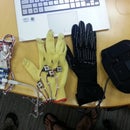Introduction: Giant Web Controlled Rover - Submitted by BayLab for the Instructables Sponsorship Program
This Instructable will show you how to turn a PowerWheels car into a web controlled rover. I'll show you how to turn even the oldest, junkiest PowerWheels car into a fast telepresence car.
Step 1: Prepping the Car
PowerWheels cars are not that hard to find, because parents buy them for their kids when they are little and then they sit in the garage when the kid gets older and can't fit in it anymore. I found my car in the yard of my neighbor and she let us have it for free. It didn't look great when we got it, but we cleaned it and painted it and it turned out quite nice. I also added a piece of wood where the seat used to be on a hinge so I could get to the electronics underneath it.
Step 2: Refurbishing the Electronics
The motors were totally rusted out when I got it, so I bought some replacements online for about $3. These are very cheap brushed DC motors that you can get from anywhere. I also got a big lead acid battery to power everything and put it underneath the seat.
In this picture, you can also see that the axle of the car is cut in half. This is because of how I had to do the steering. I had basically no money, so rather than install a big expensive servo to turn the steering, I just ripped off the front wheels and replaced it with an old single caster. The to steer, the back wheels were used like tank control, each one capable of different directions. I used a hacksaw to cut the axle to allow independent movement.
In this picture, you can also see that the axle of the car is cut in half. This is because of how I had to do the steering. I had basically no money, so rather than install a big expensive servo to turn the steering, I just ripped off the front wheels and replaced it with an old single caster. The to steer, the back wheels were used like tank control, each one capable of different directions. I used a hacksaw to cut the axle to allow independent movement.
Step 3: Adding New Electronics
To control the motors, I just used an Arduino driving some motor controllers. I tried to use some small BaneBots controllers, but they didn't end up being powerful enough. Instead I used a Sabertooth controller that was capable of higher current. You can use whatever controller you've got handy, build your own, or buy one. If you want to buy one, I recommend the Sabertooth.
The final product had two 256 bit channels for rear wheel drive, the ability to stream live video, lights, speakers and a launch tube to fire model rockets (with an encoder, so we could calculate the parabola it would take). It communicated over Wifi, and had two network cards so it could switch networks without loosing connectivity. I wanted to use a cell phone for when we couldn’t find Wifi, but we didn’t have the budget for that. Instead, you could control it with an ad-hoc network if there was no Wifi.
The final product had two 256 bit channels for rear wheel drive, the ability to stream live video, lights, speakers and a launch tube to fire model rockets (with an encoder, so we could calculate the parabola it would take). It communicated over Wifi, and had two network cards so it could switch networks without loosing connectivity. I wanted to use a cell phone for when we couldn’t find Wifi, but we didn’t have the budget for that. Instead, you could control it with an ad-hoc network if there was no Wifi.
Step 4: Enclosures
I used an old sprinkler box to house all the electronics. I also used a small metal enclosure to house the E-stop and power switches. It's not real pretty on the inside, but it works and it's better than having it all loose inside the car. I later rebuilt the electronics enclosure using an old PSU from a computer that looks way better.
Step 5: Teleoperation and Code
You can download all the code for running this project here.
For software, I wrote the code that ran on the microcontroller, which sent PWM to our Sabertooth 2×25 speed controller to drive the back wheels. To actually drive the rover, I wrote a central control webpage in PHP that sent commands to the microcontroller and allowed the user to control everything on the rover as well as see diagnostic information to help with troubleshooting.
For software, I wrote the code that ran on the microcontroller, which sent PWM to our Sabertooth 2×25 speed controller to drive the back wheels. To actually drive the rover, I wrote a central control webpage in PHP that sent commands to the microcontroller and allowed the user to control everything on the rover as well as see diagnostic information to help with troubleshooting.
Step 6: Charging
I added a batter charging port to the fake gas port on the car by drilling out a hole and adding a cigarette lighter style connector. I simply ran the wires under the chassis to the battery.
Step 7: Demo
In this video, my friend in Michigan is controlling the rover in my driveway in Florida.




